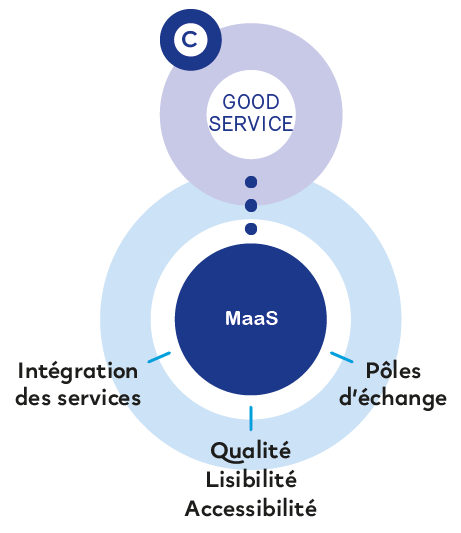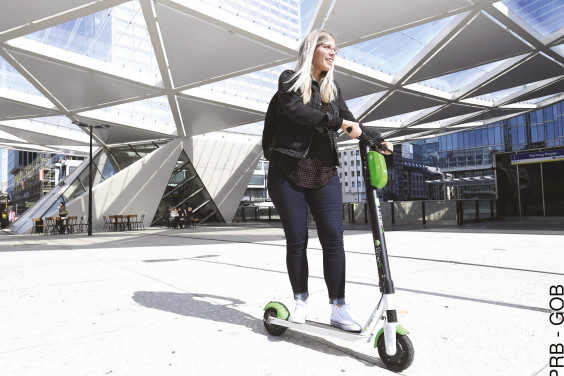
Many citizens are forced to choose their mode of transport depending on the climate, private or professional constraints, their physical abilities and their financial capacities. Good Move aims to offer users a range of integrated services, which replace the need to own a personal car, and which promote the combination of modes of travel and public transport networks. To do this, the Region has
chosen three main areas of development:
- Bring the transport options together, both digitally and physically, in terms of information, reservation and price, to facilitate mobility and multimodality;
- Increase the quality, readability and accessibility of public transport networks and services;
- Strengthen the interconnection of different services and intermodality through the development of hubs.
The term Mobility as a Service includes the integration of the transport offer into digital applications and platforms. The "service" approach to mobility allows mobility practices to be dissociated from vehicle ownership. Thanks to the combination of existing transport networks and new forms of mobility, MaaS offers solutions for getting around, which are customised according to the users and which adapt to their travel needs.
More info (French or Dutch) :
Bruxelles Mobilité a développé des guides techniques pour aider les chefs de projet en matière d'aménagement de l'espace public.
Voir aussi : le Guide de l’espace public bruxellois, Pyblik pour les concepteurs chargés de l’aménagement des espaces publics
Mobility as a Service

Brussels today has a highly diverse mobility offer which includes various shared services, but it is nevertheless presented as a juxtaposition of products and concepts rather than as an integrated and clear service for users. Indeed, mobility is still acquired mainly through the purchase of transport tickets or a vehicle. In recent years, a mobility offer has been developed in Brussels that is presented more as a service: taxis, cars, bicycles and scooters, self-service and rental, etc. This trend will be reinforced with the advent of connectivity technologies. The Region wants to increase the overall efficiency of this system in order to achieve its mobility objectives, by improving the quality of the mobility offer for the benefit of the user. The user will then have access to the combined offer of the various operators through a single, customisable interface, while benefiting from standardised information and payment methods.
Another important aspect of the MaaS deployment, in which the Region has a central role to play, is to organise the sharing of mobility data. Indeed, data is the raw material of the smart city; it can be transformed into new services! Thus, Brussels Mobility has collected and collated a range of data related to mobility and public works in geographical information systems (Mobigis), which are accessible to the public and provide various interactive maps. In addition, the Brussels public sector has also gathered a wealth of information related to mobility on its Open Data Store portal. One of the Region's objectives, through this channel, is to allow citizens or mobility professionals to consult this data or to reuse it to create mobile applications facilitating mobility for all!
Finally, within the Smart Mobility Committee platform, Brussels Mobility brings together all mobility stakeholders in order to develop a coordinated, transversal and multidisciplinary approach to mobility issues in general.
Brussels Smart Mobility
Today we need to change the way we travel and transport our goods in order to find a solution to traffic jams, improve road safety, reduce the adverse consequences of motorised travel on the habitat and the environment, address inequalities in mobility, etc. In short, we want a capital that is easily accessible in an attractive public space. The Smart City can help us to do this by developing intelligent solutions based on data and technology to improve the quality of life in the city. Indeed, the "smart" city allows mobility to be managed efficiently using the existing infrastructure, technology to be used for greater interaction and collaboration to be improved between the different mobility stakeholders.
The Smart City Committee
This is why Brussels Mobility brings together all mobility stakeholders in the Smart Mobility Committee platform in order to develop a coordinated, transversal and multidisciplinary approach to mobility in general. In short, this is a public support committee for Mobility as a Service (MaaS) bringing together the public sector (hub.brussels, Innoviris, STIB, CIRB, parking.brussels, Brussels Environment and the SNCB), the private sector, academics and researchers. They are working together to tackle the real challenge of "smart" mobility: encouraging multimodal travel, making the city more easily accessible, reducing the environmental damage and making the best use of public space. This welcome cooperation in a rapidly expanding sector will make it possible to promote and achieve a real change in behaviour.
The Smarter Cities Challenge
Brussels Mobility's victory in IBM's Smarter Cities Challenge in 2015 gave it free access to the expertise of this IT giant. For three weeks, six experts from different countries analysed how to improve the Region's mobility, drawing on available data and interviewing some 40 specialists and stakeholders. This work resulted in a first set of recommendations that you can discover in the Smarter Cities Challenge Report.
